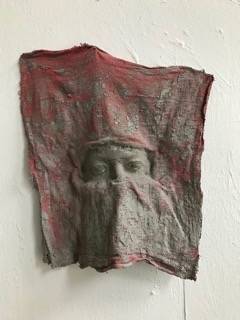By Yasmine K. Kasem
Featured artist at San Juan Islands Museum of Art
Growing up in the Midwest, I never thought of myself as different from my peers. No, I didn’t go to a church like my friends, and I often had to explain that I couldn’t eat the pepperoni pizza at school because I am Muslim. On Sept. 11, 2001, I would quickly and abruptly feel myself cast into the role of the “other.”
I was only 8 years old, so I didn’t really understand the gravity of the situation, but I remember being confused about why my religion was being demonized. My pizza explanation suddenly turned into a longer speech, condemning the acts of terrorists and the hijacking my religion, and convincing my peers that I, my family and the overwhelming majority of Muslims oppose those acts — as best as an 8-year-old could.
I learned that my identity as an Egyptian Muslim woman in the U.S. was controversial. Yet, I refused to be ashamed of it and actively sought out my Egyptian heritage. In doing that, I found myself venturing deeper into the middle ground amongst cultures — the limbo between.
As a teenager, I fell in love with Egypt feeling more at home there than in Indiana. I studied Arabic, cultural events and history of the region. I began to identify myself as an Egyptian who happened to live in America.
A bridal shower in Egypt sparked the most recent identity crisis. Stepping off the narrow streets lined with towering sunbaked homes, I entered a swirl of color, sound and movement. Women, seated in a circle, were focused on preparing pastries. Excited teenage girls took my arms to escort me upstairs to sing karaoke, common at showers. However, our excitement ended when I didn’t recognize a song they wanted me to sing. At that moment, the girls and I understood that I was not one of them.
That instant cast me into the limbo from which I had spent so many years escaping. I desperately wanted a place where I didn’t have to explain myself; a place where I wouldn’t feel foreign. I have since come to accept that dwelling in the middle creates a space for itself and a space for me.
That is how my sculpture evolved. “Masricani” means “Egyptian – American,” a combination of the words in Arabic, uniting them into one — both, but not wholly either. That I choose to say I am “Masricani” is to give myself some ground to stand on as a person both Egyptian and American.
Entering “Masricani” at the San Juan Islands Museum of Art, visitors encounter a scene from my memory. Dusty, cement-clad portraits from the streets of an Egyptian village shape a private visual tumult of color and pattern, an environment formed by emotion, identity and memory.
The Female Gaze: The Woman as Visionary and Creator will open Feb. 17. Watch for Yasmine’s talk on March 24. Exhibited are “Masricani” by Kasem, “Through My Lens” by Imogen Cunningham and “Substrate: Underlying Currents” by Singleton, Susol and Alex-Glasser.
For more information or questions contact RaVae Luckhart at 360-378-7737 or ravaeluckhart@gmail.com.




